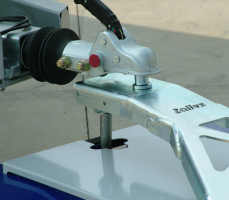
The way capacities are worked out is how much force is put on the towball or hitch. This is called “draw bar pull”.
Everyone knows that is much harder to push a shopping trolley up a hill than on flat ground. This is the same for a towing vehicle and means the capacity to tow is affected by the slope of the ground.
There are many different ways to work out how much a slope affects capacity.
When dealing with Taylor Dunns Warequip use the following methods.
We start by nominating a draw bar pull for flat level ground. The way this is done is to work out the stall point for the motor by attaching a spring gauge to the back of the machine and pulling against it. The machine can not move as the spring is fixed to a wall at the other end. The spring gauge peaks at what is called the ultimate draw bar pull. A quarter of this is what we call the “rated drawbar pull”
Formula – Draw Bar Pull on Level Ground
The drawbar pull divided by 2, times 100 = Weight that can be pulled
The trailer weight plus load times .02 = Drawbar pull required
Formula – Determine Loads with Known Draw Bar Pull and a Slope
The draw bar pull divided by (2+% of grade), times 100 = Weight that can be pulled
Formula – Determine Draw Bar Pull with Known Loads and a Slope
The towing load (trailer + load) times (2 +% of grade) divided by 100 = Drawbar pull required
Please note we are using % gradients, not degrees.
To establish what % it is get a level, have one end touching the ground, get the bubble in the middle and measure down from the other end of the level to the ground.
If the level is 400mm long and the down measurement is 20mm then it is a 1 in 20 gradient (20 / 100 = 5) so it is a 5% slope.